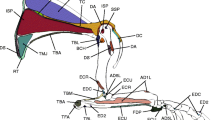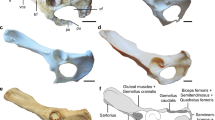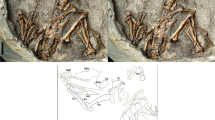Abstract
In the present work, we provide muscular reconstruction and we infer functional properties of the forelimb of Plesiotypotherium achirense, a fossil mesotheriid notoungulate from the late Miocene of Achiri (Bolivia). This locality has yielded the widest sample ever available for the forelimb of a mesotheriid. In addition, we propose a qualitative comparison of the forelimb (osteology and myology) at the family level, including the Miocene–Pleistocene mesotheriines Mesotherium cristatum, Plesiotypotherium achirense, Caraguatypotherium munozi, Plesiotypotherium casirense, and Pseudotypotherium sp, and the late Oligocene trachytheriine Trachytherus alloxus. Functional properties are consistent with a digging ability and a “scratch-digger” lifestyle for Mesotheriidae. In general, there are only slight differences among the comparison sample, except for Mesotherium cristatum, which reflect significant osteological modifications, likely to help increasing the moment arm while scratch-digging. These features are mainly observable on scapulae (distal border caudally displaced) and humeri (deltoid crest distally oriented and crista supracondylaris lateralis laterally projected).










Similar content being viewed by others
References
Agrawal VC (1967) Skull adaptations in fossorial rodents. Mammalia 31:300-312
Ameghino F (1889) Contribución al conocimiento de los mamíferos fósiles de la República Argentina. Acad Nac Cienc Córdoba 6:918-919
Ameghino F (1891) Observaciones sobre algunas especies de los géneros Typotherium y Entelomorphus. Rev Arg Hist Nat: 1:433-437
Argot C (2001) Functional-adaptative anatomy of the forelimb in the Didelphidae, and the paleobiology of the Paleocene marsupials Mayulestes ferox and Pucadelphys andinus. J Morphol 247:51-79
Argot C (2012) Postcranial analysis of a carnivoran-like archaic ungulate: the case of Arctocyon primaevus (Arctocyonidae, Mammalia) from the late Paleocene of France. J Mammal Evol 20:83-114
Billet G, Muizon C de, Mamani Quispe B (2008) Late Oligocene mesotheriids (Mammalia, Notoungulata) from Salla and Lacayani (Bolivia): implications for basal mesotheriid phylogeny and distribution. Zool J Linn. Soc 152:153-200
Bond M, Cerdeño E, López G (1995) Los ungulados nativos de América del Sur. Mon Mus Nac Cienc Nat: Cons Sup Inv Cient Madrid 12:257-276
Bou J, Castiella JJ, Casinos A (1990) Multivariate analysis and locomotor morphology in insectivores and rodents. Zool Anz 225:287-294
Candela AM, Picasso MBJ (2008) Functional anatomy of the limbs of Erethizontidae (Rodentia, Caviomorpha): indicators of locomotor behavior in Miocene porcupines. J Morphol 269:552-593
Cartmill M (1974) Pads and claws in arboreal locomotion. In: FA Jenkins Jr (ed) Primate Locomotion. Academic Press, New York, pp 45-83
Cattoi N (1943) Osteografía y osteometría comparada de los géneros Typotheriodon and Typotherium. Mus Arg Cienc Nat Buenos Aires, 119 pp
Cerdeño E, Vera B, Schmidt GI, Pujos F, Mamani Quispe B (2012) An almost complete skeleton of a new Mesotheriidae (Notoungulata) from the late Miocene of Casira, Bolivia. J Syst Palaentol 10:341-360
Croft DA (2007) The middle Miocene (Laventan) Quebrada Honda Fauna, southern Bolivia and a description of its notoungulates. Palaeontology 50: 277-303
Croft DA, Anderson LC (2008) Locomotion in the extinct notoungulate Protypotherium. Paleontol Electron 11:1-20
Croft DA, Flynn JJ, Wyss AR (2004) Notoungulata and Litopterna of the early Miocene Chucal Fauna, northern Chile. Fieldiana Geol 50:1-52
Davis DD (1949) The shoulder architecture of the bears and other carnivores. Fieldiana Zool 31:285-305
Davis DD (1964) The giant panda: a morphological study of evolutionary mechanism. Fieldiana Zool 3:1-339
De Iuliis G, Pulera D (2010) Dissection of Vertebrates: A Laboratory Manual. Elsevier/Academic Press, Amsterdam
Ebensperger LA, Bozinovic F (2000) Energetics and burrowing behaviour in the semifossorial Octodon degus (Rodentia: Octodontidae). J Zool 252:179-186
Elissamburu A, Vizcaíno SF (2004) Limb proportions and adaptations in caviomorph rodents (Rodentia: Caviomorpha). J Zool Lond 262:145-159
Ercoli MD, Álvarez A, Stefanini MI, Busker F, Morales MM (2014) Muscular anatomy of the forelimbs of the lesser grison (Galictis cuja), and a functional and phylogenetic overview of Mustelidae and other caniformia. J Mammal Evol 22:57-91
Fisher RE, Adrian B, Barton M, Holmgren J, Tang SY (2009) The phylogeny of the red panda (Ailurus fulgens): evidence from the forelimb. J Anat 215:611-635
Flynn JJ, Croft DA, Charrier R, Wyss AR, Hérail G, García M (2005) New Mesotheriidae (Mammalia, Notoungulata, Typotheria), geochronology and tectonics of the Caragua area, northernmost Chile. J South Am Earth Sci 19:55-74
Gambaryan PP (1974) How Mammals Run: Anatomical Adaptations. John Wiley and Sons, New York.
Gervais P (1867) Sur une nouvelle collection d’ossements fossiles de mammifères recueillie par M. Fr. Seguin dans la confédération argentine. C R Acad Sci 55:279-282
Gervais P (1869) Zoologie et paléontologie générales: nouvelles recherches sur les animaux vertébrés vivants et fossiles. Librairie de la Société de Géographie, Paris 5:1-56
Gomper ME (1995) Nasua narica. Mammal Spceies 487:1-10
Hammer Ø, Harper DAT, Ryan PD (2001) PAST: Paleontological statistic package for education and data analysis. Paleontol Electron 4, 9
Hickman GC (1985) Surface-mound formation by the tuco-tuco Ctenomys fulvus (Rodentia: Ctenomydae), with comments on earth-pushing in other fossorial mammals. J Zool 3:385-390
Hildebrand M (1974) Analysis of Vertebrate Structure. John Wiley & Sons Inc, New York
Hildebrand M (1985) Digging of Quadrupeds. Belknap Press of Harvard University Press, Cambridge
Hildebrand M, Goslow G (2001) Analysis of Vertebrate Structure. John Wiley & Sons Inc, New York
Holliger CD (1916) Anatomical Adaptations in the Thoracic Limb of the California Pocket Gopher and Other Rodents. University of California Press, Berkeley
Kardong KV (2002) Vertebrates: Comparative Anatomy, Function, Evolution (3rd ed). McGraw-Hill, Boston
Kielan-Jaworowska Z, Cifelli RL, Luo Z-X (2004) Mammals from the Age of Dinosaurs:Origins, Evolution, and Structure. Columbia University Press, New York
Kley NJ, Kearney M (2007) Adaptations for digging and burrowing. In: Hall B (ed) Fins into Limbs: Evolution, Development, and Transformation. University of Chicago Press, Chicago, pp 284-309
Landry SO (1958) The function of the entepicondylar foramen in mammals. Am Midl Nat 60:100-112
Larson SG (1993) Functional morphology of the shoulder in primates. In: Gebo DL(ed) Postcranial Adaptation in Nonhuman Primates. Northern Illinois University Press, DeKalb, pp 45-69
Lessa EP, Stein BR (1992) Morphological constraints in the digging apparatus of pocket gophers (Mammalia: Geomyidae). Biol J Linn Soc 47:439-453
Lessa EP, Thaeler CS Jr (1989) A reassessment of morphological specializations for digging in pocket gophers. J. Mammal 70:689-700
Loomis FB (1914) The Deseado Formation of Patagonia. Runford Press, Concord
Marshall LG, Swisher CC, Lavenu A, Hoffstetter R, Curtis GH (1992) Geochronology of the mammal-bearing late Cenozoic on the northern Altiplano, Bolivia. J South Am Earth Sci 5:1-19
Maynard Smith J, Savage RJG (1956) Some locomotory adaptations in mammals. Zool J Linn Soc 42:603-622
McEvoy JS (1982) Comparative myology of the pectoral and pelvic appendages of the North Amercian porcupine (Erethizon dorsatum) and the prehensile-tailed porcupine (Coendou prehensilis). Bull Am Mus Nat Hist 173:337-421
Meng J, Hu YM, Li CK (2003) The osteology of Rhombomylus (Mammalia, Glires): implications for phylogeny and evolution of glires. Bull Am Mus Nat Hist 275:1-247
Michener GR (2004) Hunting techniques and tool use by North American badgers preying on Richardson's ground squirrels. J Mammal 85:1019-1027
Muizon C de (1998) Mayulestes ferox, a borhyaenoid (Metatheria, Mammalia) from the early Palaeocene of Bolivia. Phylogenetic and palaeobiological implications. Geodiversitas 20:19-142
Olson RA, Womble MD, Thomas DR, Glen ZD, Butcher MT (2015) Functional morphology of the forelimb of the nine-banded armadillo (Dasypus novemcinctus): comparative perspectives on the myology of Dasypodidae. J Mammal Evol 23:49-69
Patterson B (1975) The fossil aardvarks (Mammalia: Tubulidentata). Bull Mus Comp Zool 147:185-237
Paz ER, Kramarz A, Bond M (2011) Mesotheriid (Mammalia, Notoungulata) remains from the Colhuehuapian beds (early Miocene) of Chichinales Formation, Río Negro Province, Argentina. Ameghiniana 48:264-269
Polly PD (2007) Limbs in mammalian evolution. In: Hall BK (ed) Fins into Limbs: Evolution, Development, and Transformation. University of Chicago Press, Chicago, pp 245-268
Rose J, Moore A, Russell A, Butcher M (2014) Functional osteology of the forelimb digging apparatus of badgers. J Mammal 95:543-558
Rose MD (1993) Functional anatomy of the elbow and forearm in primates. In: Gebo DL (ed) Postcranial Adaptation in Nonhuman Primates. Northern Illinois University Press, Dekalb, pp 70–95
Rovereto C (1914) Los estratos araucanos y sus fósiles. Anales Mus Nac Hist Nat Buenos Aires 25: 1-250
Saint-André P-A (1993) Hoffstetterius imperator n. g., n. sp. du Miocène supérieur de l'Altiplano bolivien et le statut des Dinotoxodontinés (Mammalia, Notoungulata). C R Acad Sc 316:539-545
Salesa MJ, Anton M, Peigné S, Morales J (2008) Functional anatomy and biomechanics of the postcranial skeleton of Simocyon batalleri (Viret, 1929) (Carnivora, Ailuridae) from the late Miocene of Spain. Zool J Linn Soc 152:593-621
Sargis EJ (2002) Fucntional morphology of the forelimbs of tupaiids (Mammalia, Scandentia) and its phylogenetic implications. J Morphol 253:10-42
Schaller O (2007) Illustrated Veterinary Anatomical Nomenclature. Enke Verlag, Stuttgart
Serres M (1867) De l’ostéographie du Mesotherium et de ses affinities zoologiques. C R Acad Sci 65:140-148
Shockey BJ, Anaya F (2008) Postcranial osteology of mammals from Salla, Bolivia (late Oligocene): form, function, and phylogenetic implications In: Sargis EJ, Dagosto M (eds) Mammalian Evolutionary Morphology: A Tribute to Frederick S Szalay. Springer, Dordrecht, pp 135-157
Shockey BJ, Croft DA, Anaya F (2007) Analysis of function in the absence of extant functional homologues: a case study using mesotheriid notoungulates (Mammalia). Paleobiology 33:227-247
Shockey BJ, Flynn JJ, Croft DA, Gans PB, Wyss AR (2012) New leontiniid Notoungulata (Mammalia) from Chile and Argentina: comparative anatomy, character analysis, and phylogenetic hypotheses. Am Mus Novitates 3737:1-64
Stein BR (2000) Morphology of subterranean rodents. In: Lacey EA, Patton JL, Cameron G (eds) Life Underground: the Biology of Subterranean Rodents. University of Chicago Press, Chicago, pp 19-62
Szalay FS, Dagosto M (1980) Locomotor adaptations as reflected on the humerus of Paleogene primates. Folia Primatol 34:1– 45
Szalay FS, Sargis EJ (2001) Model-based analysis of postcranial osteology of marsupials from the Paleocene of Itaboraí, Brazil, and the phylogenetics and biogeography of Metatheria. Geodiversitas 23:139-302
Taylor BK (1978) The anatomy of the forelimb in the anteater (Tamandua) and its functional implications. J Morphol 157:347-368
Villarroel C (1974) Les mésothérinés (Notoungulata, Mammalia) du Pliocène de Bolivie et leurs rapports avec ceux d'Argentine. Ann Paléontol 60:245-281
Waibl H, Gasse H, Hashimoto Y (2005) Nomina Anatomica Veterinaria. International Committee on Veterinary Gross Anatomical Nomenclature, World Association of Veterinary Anatomists, Hannover
Acknowledgments
We thank A. Kramarz and S. Alvarez (MACN, Buenos Aires, Argentina), C. de Muizon, C. Argot, and G. Billet (MNHN, Paris, France), and D. Rubilar (SGOPV, Santiago, Chile) who kindly gave access to the specimens under their care. We are grateful to R. C. Hulbert. Jr (FLMNH, Gainesville, USA) for sending and allowing us to reproduce images of Trachytherus alloxus (UF 91933) and to D. A. Croft for providing measurements of this specimen.
We thank all the team members (M. A. Abello, S. Adnet, G. Billet, L. Marivaux, M. B. Prámparo, P. Münch, and R. Andrade Flores) who participated in the collecting of the specimens from Achiri in 2010–2015). We are grateful to N. Toledo for helpful discussions on an earlier version of the manuscript. Finally, we thank MEDICENTRO clinic of La Paz (Bolivia) for providing us access to their computed tomography facility.
We warmly thank people from Achiri for facilitating our fieldwork (2010–2015). This work was partially funded by ECOS-FonCyT (A14U01). This project was made possible thanks to the cooperation agreement between the MNHN-Bol (Bolivia), the ISEM (France), and the CONICET (Argentina, CONICET Cooperation agreement N°864/2014).
Author information
Authors and Affiliations
Corresponding author
Rights and permissions
About this article
Cite this article
Fernández-Monescillo, M., Quispe, B.M., Pujos, F. et al. Functional Anatomy of the Forelimb of Plesiotypotherium achirense (Mammalia, Notoungulata, Mesotheriidae) and Evolutionary Insights at the Family Level. J Mammal Evol 25, 197–211 (2018). https://doi.org/10.1007/s10914-016-9372-7
Published:
Issue Date:
DOI: https://doi.org/10.1007/s10914-016-9372-7




